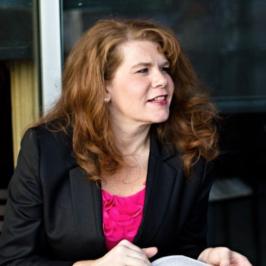On August 14, 2018, I clicked the “submit” button to complete my one-hundredth literary submission this year. I waited for some kind of congratulatory message to float across my computer screen. Instead, I got a bit teary, surprised at what I had accomplished in less than eight months.
In 2012, I left full-time work to focus on writing after a twenty-year career in marketing and executive management. Though I had some writing experience—for a time I published features articles in the Orange County Register as a side gig—I wanted to work on my craft.
A few years later, in 2015, I completed my MFA in creative nonfiction with a nearly complete memoir about my relationship with my body. When I pitched agents at the San Francisco Writer’s Conference the following year, six said they wanted to see chapters and a proposal. However, I was still living the ending of the story, too close to the material, and unable to finish. I was stuck.

‘I’m a Taurus, the sign of the bull, and ‘stubborn’ is in my wheelhouse.’ Illustration by Josh Quick.
Then last year, in August of 2017, I attended a submission party for Women Who Submit (WWS), an organization built to help women and nonbinary writers support and learn from one another in their quest to publish work.
At my first meeting, someone suggested the goal of one hundred submissions in a year. Impossible! I thought. How could anyone do that? After all, I had only submitted one essay to a literary magazine since obtaining my graduate degree.
But I wanted to make progress as a writer, even while waiting for the perspective I needed to finish my memoir. In early January I attended a writing workshop on the topic of ultra-flash essays. At the time, the Brevity podcast had a call with a deadline two days later for one-minute memoirs, personal stories told in just 100-150 words. The possibility and challenge of storytelling in tight confines excited me. Additionally, I didn’t have time to overthink it. I worked on my story, drafted a cover letter, and sent off my first submission of the year on January 4.
The following week, I began studying literary magazines and deadlines. I read the journals on Clifford Garstang’s ranking, used the Discover feature on Submittable, read submission calls in industry newsletters and magazines, and tracked opportunities and deadlines in a spreadsheet. I took inventory of all my writing, looking at chapters and scenes to see if they could stand on their own. I also started writing new essays and more flash prose.
In March I volunteered to report on three sessions at the Association of Writers and Writing Program (AWP) Conference for Assay: A Journal of Nonfiction Studies, securing my first three publication credits for the year. While attending AWP, I walked the massive book fair. Editors answered questions about what they were seeking or didn’t want to read. Some told me they rarely published unsolicited work but urged me to participate in contests or themed issues. At the Submittable booth, I heard about a fellowship opportunity for which I was qualified. The more I learned, the more I tightened my strategy.
Then, at the same time, I was improving my ability to target submissions, I learned that T.S. Eliot was right when he wrote: “April is the cruelest month.” I had received a couple rejections already but as spring came to a close, journal staffs were reading their way through slush piles. For several weeks, I woke almost every morning to a “no thanks.” I understood that rejections weren’t personal. I knew I was playing a numbers game. But even the emails that explained I was a finalist for publication stung a little. I had underestimated the feeling of so many refusals in a compressed period of time.
Luckily, I had the words of Sue William Silverman ringing in my head. I was fortunate to work with the accomplished author during my MFA and continued to seek her guidance. Twice, she told me that the writers that eventually succeed are simply the ones who refuse to quit. I’m a Taurus, the sign of the bull, and “stubborn” is in my wheelhouse. I kept submitting.
Soon, I began to see positive results. I was invited to write an essay for the website Past Ten. Then, I learned I was the first-place runner-up in Beecher’s Magazine’s nonfiction contest. I received Submittable’s Eliza So “Finish Your Book” Fellowship and an acceptance from Wanderlust: A Narrative Map. In July, Memoir Magazine accepted an essay. By early August, Storm Cellar, Linea, and *82 Review had accepted five pieces. Rejections improved, too.
Several editors personalized feedback with requests that I send more work during the next reading periods. In October, I learned I had placed in Midway Journal’s flash contest. In November, I received an acceptance from Mom Egg Review just before Submittable published my essay, “What Happens in Vegas.” Finally, I received news that Midway Journal nominated the piece they published for a Pushcart Prize.
I expect to complete one hundred and fifty submissions by year’s end. While it wasn’t easy, it was definitely possible. Along the way, I learned several valuable lessons.
1. Start Somewhere
Since there’s an opportunity to improve with each submission, submitting anything is better than nothing. My first three submissions were rejected but the fourth was a finalist for publication. Each time I worked on a new submission, I improved my skills by reading great literary work in that journal. Improvement occurs naturally as a result of the process, so just begin.
2. Never Underestimate the Importance of Your Writing Community
I was accepted by one journal after I learned of the submission call through a friend. Another acceptance came after seeing a call in a Facebook group. Whether I was in contact with friends from my MFA cohort or attending the WWS meetings, I came to realize that there’s room for all of us while I continued to fight for my spot in a competitive field.
3. Rejection Is a Gift, Albeit an Uncomfortable One
There’s always a lesson to learn when the answer is “no.” Rejection has improved my work because each time I submit a piece, I find new ways to tighten language, strike unnecessary sentences, enhance description, or improve word choice. Rejection also teaches discernment. I understand that most editors have to turn away plenty of great writing because they only have so much space or a specific editorial focus. Similarly, I have limited time and resources. Rejection reminds me that I can’t say yes to every opportunity but instead, need to choose the ones in line with overall goals and objectives. Finally, rejection can provide useful insight. Similar feedback from two editors helped me see that I needed to revise a piece of flash into a full-length essay.
4. When You Can’t Write, Read
When troubled by national or world events, upset enough that I had difficulty returning to the emotional work of writing, I read. If moved by another’s work, I reached out to the author and shared links on social media. I also began volunteering with a writing nonprofit. By taking time to practice literary citizenship, I felt greater connectivity to others and regained a sense of hope. When I focus too much on my own work, my ego takes over and I lose sight of what’s truly important. But when other people’s stories thrill me and I let them know, not only do I put good into the world but I am reminded of the greater purpose in my own work.
5. Play with words
Try something new. Responding to specific themed-calls or contests gave me a chance to write in new ways. In May, I responded to Rattle’s monthly ekphrastic challenge with a prose poem that was unlike anything I had previously written. The act of experimentation brought joy into the work. I didn’t win the contest but I revised the piece into microfiction which was accepted by another journal.
6. Adapt as Necessary but Keep Writing, Stay Stubborn, and Keep Submitting
When I look back on the last year, I liken the experience to the protagonist embarking on the hero’s journey. I’ve encountered helpers, mentors, and, at times, gifts that came from a supernatural place. When I faced obstacles, I made adjustments and moved forward. This isn’t the final chapter in my story. I’ve only begun, so I can’t tell you what the ending looks like. But if you have stories you need to tell, somewhere someone needs to read your words so keep writing, stay stubborn, and keep submitting.

